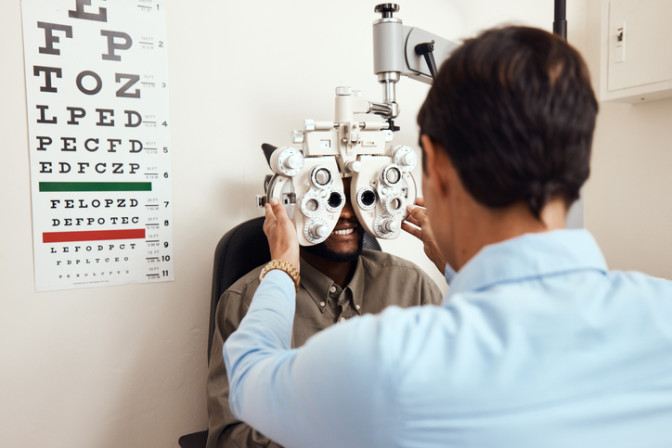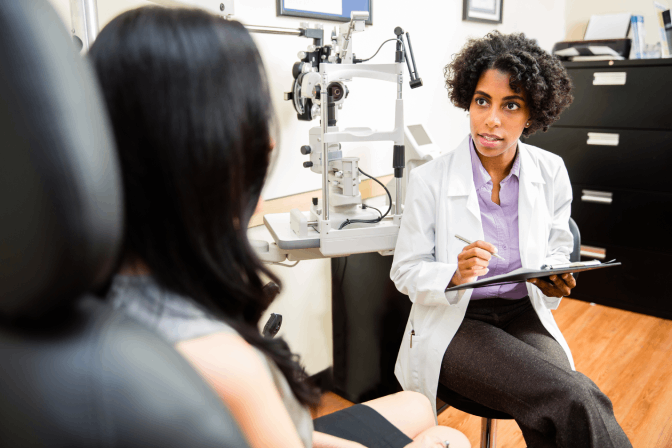50% OFF a Complete Pair of Glasses
*Restrictions apply. Click here for details.

Regular vs. Diabetic Eye Exams: What's the Difference?
Regular yearly eye exams are an extremely important part of maintaining healthy vision. During your annual eye exam, your doctor will check for certain ocular conditions. The main purpose of these exams is to update your prescription so you can get glasses or contacts that are better suited to correct your vision. However, if you have diabetes, there’s a lot more that goes into protecting your eye health.
Diabetes can cause many serious eye conditions that can quickly damage your vision if left untreated. Not only should you get more frequent eye exams, but you’ll also need specialized exams designed to check for different diabetic eye conditions or to monitor the progress of conditions you’re currently undergoing treatment for.
The experts at Clarkson Eyecare are specifically trained to conduct thorough diabetic eye exams and develop treatment plans designed to meet your unique needs. In this article, we break down what to expect from a regular eye exam and a diabetic eye exam and which one might be better suited to your eyes.
What to Expect from a Regular Eye Exam
Regardless of if you have diabetes or not, it’s still a good idea to get regular eye exams to update your prescription and check for threats to your eye health.
During a regular eye exam, the doctor will first measure your visual acuity by having you read a series of letters on a chart, with the letters getting smaller the farther down they go. This is called a Snellen Eye Chart and is used to judge how your vision performs at different distances.

Your doctor will then use an instrument called a phoropter to get the precise measure of your prescription. This is a metal device with different lenses that the doctor will put in front of your face. By switching lenses and asking you which of the power levels makes your vision clearer, your doctor can pinpoint the exact strength of your prescription.
If you have opted for a comprehensive eye exam, the doctor will pull back the phoropter and put drops in your eyes to dilate them. Your eyes may itch or burn slightly right after the drops are applied, you may have trouble focusing on objects, and your near vision may be blurry, but this will only last for a few hours after the exam.
For many patients, pupil dilation is the most disliked part of the entire exam because of how it alters vision and makes their eyes feel. However, it is crucial to examine your eyes for conditions that may be lurking inside without any symptoms. Several serious sight-stealing eye conditions, like glaucoma, don’t display noticeable symptoms until vision has been permanently damaged. Catching them early and beginning treatment is the only way to preserve healthy vision.
Once the pupils are fully dilated, the doctor will use a special lighted magnifying glass, called an ophthalmoscope, to view the internal structures of the eye. This is used to check for any abnormalities in the back of the eye that might indicate a serious condition is present.
The doctor may also use an instrument called a slit lamp, which projects a horizontal line of light onto the eye. This is used to check the eye’s surface structures such as the cornea, lens, and iris.
The Main Purpose of Regular Eye Exams
Although complete eye exams are used to check for and diagnose eye conditions that pose a serious threat to your vision, the main purpose of a regular eye exam is to update your prescription so you can get glasses or contacts that help you see more clearly. Some general eye care practitioners even focus solely on testing visual acuity during a regular eye exam and may recommend you see an ophthalmologist or a different eye doctor to perform other tests to measure your eye’s overall health.
All Clarkson Eyecare doctors can perform comprehensive eye exams that include both visual acuity and ocular health examinations. We’re committed to helping our patients maintain clear, healthy vision for as long as possible, which is why we insist on testing for serious eye conditions during your annual exam.
What to Expect During a Diabetic Eye Exam

If you have type one or type two diabetes, you should get a diabetic eye exam at least once a year. There is a lot of overlap between a comprehensive eye exam and a diabetic eye exam with a few key differences.
Here’s what to expect from a diabetic eye exam.
You Will Answer Questions About Family History
To best understand how your diabetes is impacting your eyes and what to look for, your doctor will ask you questions about your condition and if there is any family history of the condition. If you’ve received treatment for a diabetic eye condition in the past, make sure to inform your doctor during the exam.
Your Pupils Will Be Dilated
Like a comprehensive eye exam, your pupils must be dilated for a diabetic eye exam. This allows doctors to get a better view of the inner parts of your eye, including the retina and macula, two areas that are often targeted by diabetic eye conditions. Your doctor will use an ophthalmoscope to see inside your eye and check for damage or abnormalities. They will also likely use a slit lamp to check the lens of your eye, as diabetes can lead to a higher risk of developing cataracts.
Your Eye Doctor Will Complete an Optical Coherence Tomography (OCT)
This fancy-sounding test is really just a series of images taken of your retinas. The images provided detailed cross-sections doctors can examine to determine if any of your blood vessels are damaged, if there’s fluid leaking into your eye, or if there’s anything of concern that might be going on beneath the surface.
Your Doctor Will Administer Digital Retinal Imaging
If your doctor does not prescribe OCT, they may ask you to get detailed photographs taken of your retina instead. You will be asked to place your eye up against a specially designed camera. Once your eye is positioned correctly, the camera will quickly snap a photo of the interior of your eye. You will see a flash, followed by a lingering after image (like if you’ve looked at a bright light) that should dissipate within a moment or two. This will be done on each eye.
Digital retinal imaging gives the doctor another tool for close-up viewing of your retina to determine if there are any detectable issues that could be signs of a diabetic eye condition forming.
You Will Take a Glaucoma Test
Glaucoma tests are often part of regular eye exams too, but they are especially important for diabetic patients because diabetes significantly increases the risk of developing glaucoma. During this test, a special instrument will be placed up against your eye to measure the internal pressure. If the pressure is unusually high, it may indicate the beginnings of glaucoma.
You Will Take a Visual Acuity Test
Just like a regular eye exam, you will also be asked to read a Snellen Eye Chart to determine your level of visual acuity. A rapid drop in visual acuity or difficulty seeing out of certain areas of your eye may indicate your eye has been damaged by a diabetic eye condition, so your doctor will use the results of the Snellen Eye Chart to determine if there have been any significant changes to your visual acuity.
The Purpose of a Diabetic Eye Exam
Unlike regular eye exams, the main purpose of a diabetic eye exam is to detect any conditions that may be affecting the different parts of your eye because of diabetes. The tests often focus on the retina, because many common diabetic eye conditions attack that part of the eye. The main goal of receiving diabetic eye exams is to quickly diagnose and begin treatment for any conditions you may have to preserve your eyesight.
It's common for optometrists to refer diabetic eye patients to ophthalmologists with special training in diabetic eye conditions to perform these exams. This can be a bit frustrating because you’ll need to find and visit a totally different doctor to treat your diabetic eye condition. However, with Clarkson Eyecare, our extensive network of eye care practitioners has you covered. In fact, many of our practices have doctors who provide general eye care and doctors who specialize in diabetic conditions, allowing you to get the same great care from one convenient location.
The Importance of Getting Diabetic Eye Exams
If you’re currently dealing with diabetes, you know it’s a serious health condition that means business. The fluctuations in blood sugar can wreak havoc on many different parts of the body, and the eyes are no exception. Many diabetic eye conditions, such as diabetic retinopathy, are caused by damage to blood vessels within the eye.
Left unchecked, these conditions can cause serious damage and even lead to permanent vision loss. The most frightening aspect of diabetic eye conditions is that they often don’t display any symptoms in their early stages. Once symptoms do appear, the conditions have already progressed to the point where they’re starting to damage your vision. Getting regular diabetic eye exams helps avoid this by getting the conditions diagnosed and treated before they can cause any major issues.
Get Diabetic Eye Exams at Clarkson Eyecare
If you have diabetes and are looking to get specialized diabetic eye care, look no further! Clarkson Eyecare has hundreds of practices across 11 states with doctors who specialize in helping diabetic eye patients manage their condition and preserve strong, healthy vision. Our highly trained eye care professionals use the latest diagnostic technology to find diabetic eye conditions before they become serious problems and create a treatment plan specifically to address your eye care needs.
We also offer comprehensive eye exams with the same level of quality and care. Whether you need diabetic eye care or an adjustment to your prescription, visit Clarkson Eyecare for vision health services in one convenient place. We’re only ever a call or click away!
Schedule your appointment today, and let's keep your eyes happy and healthy for years to come.
